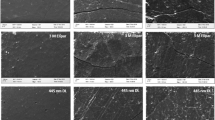Abstract
The aim of this in vitro study was to evaluate the effect of radiant heat on surface hardness of three conventional glass ionomer cements (GICs) by using a blue diode laser system (445 nm) and a light-emitting diode (LED) unit. Additionally, the safety of the laser treatment was evaluated. Thirty disk-shaped specimens were prepared of each tested GIC (Equia Fil, Ketac Universal Aplicap and Riva Self Cure). The experimental groups (n = 10) of the study were as follows: group 1 was the control group of the study; in group 2, the specimens were irradiated for 60 s at the top surface using a LED light-curing unit; and in group 3, the specimens were irradiated for 60 s at the top surface using a blue light diode laser system (445 nm). Statistical analysis was performed using one-way ANOVA and Tukey post-hoc tests at a level of significance of a = 0.05. Radiant heat treatments, with both laser and LED devices, increased surface hardness (p < 0.05) but in different extent. Blue diode laser treatment was seemed to be more effective compared to LED treatment. There were no alterations in surface morphology or chemical composition after laser treatment. The tested radiant heat treatment with a blue diode laser may be advantageous for the longevity of GIC restorations. The safety of the use of blue diode laser for this application was confirmed.


Similar content being viewed by others

References
Reichelt J, Winter J, Meister J, Frentzen M, Kraus D (2016) A novel blue light laser system for surgical applications in dentistry: evaluation of specific laser-tissue interactions in monolayer cultures. Clin Oral Investig. doi:10.1007/s00784-016-1864-6
Boulnois JL (1986) Photophysical process in recent medical laser developments: a review. Lasers Med Sci 1:47–66
Hatayama H, Inoue A, Kato J (2008) Study on use of blue-violet laser diode module as dental/oral surgical device. SEI Tech Rev 66:142–146
Fornaini C, Merigo E, Selleri S, Cucinotta A (2016) Blue diode laser: a new approach in oral surgery? J Biomed Opt. doi:10.1117/12.2211012
Dionysopoulos D (2014) The effect of fluoride-releasing restorative materials on inhibition of secondary caries formation. Fluoride 47:258–265
Mount GJ (1998) Clinical performance of glass ionomers. Biomaterials 19:573–579
Rodriguez IA, Ferrara CA, Campos-Sanchez F, Alaminos M, Echevarría JU, Campos A (2013) An in vitro biocompatibility study of conventional and resin-modified glass ionomer cements. J Adhes Dent 15:541–546
Kleverlaan CJ, van Duinen RNB, Feilzer AJ (2004) Mechanical properties of glass ionomer cements affected by curing methods. Dent Mater 20:45–50
de Gee AJ, van Duinen RN, Werner A, Davidson CL (1996) Early and long-term wear of conventional and resin-modified glass ionomers. J Dent Res 75:1613–1619
Yap AUJ, Cheang PHN, Chay PL (2002) Mechanical properties of two restorative reinforced glass-ionomer cements. J Oral Rehabil 29:682–688
Tolidis K, Dionysopoulos D, Gerasimou P, Sfeikos T (2016) Effect of radiant heat and ultrasound on fluoride release and surface hardness of glass ionomer cements. J Appl Biomater Funct Mater. doi:10.5301/jabfm.5000292
Dehurtevent M, Deveaux E, Hornez JC, Robberecht L, Tabary N, Chai F (2015) Influence of heat and ultrasonic treatments on the setting and maturation of a glass-ionomer cement. Am J Dent 28:105–110
Towler MR, Bushby AJ, Billington RW, Hill RG (2001) A preliminary comparison of the mechanical properties of chemically cured and ultrasonically cured glass ionomer cements, using nano-indentation techniques. Biomaterials 22:1401–1406
Nicholson JW (1998) Chemistry of glass-ionomer cements: a review. Biomaterials 19:485–494
O’Brien T, Shoja-Assadi F, Lea SC, Burke FJT, Palin WM (2010) Extrinsic energy affect hardness through depth during set of a glass-ionomer cement. J Dent 38:490–495
Musanje L, Shu M, Darvell B (2001) Water sorption and mechanical behaviour of cosmetic direct restorative materials in artificial saliva. Dent Mater 17:394–401
Gavic L, Gorseta K, Borzabadi-Farahani A, Tadin A, Glavina D, van Duinen RN, Lynch E (2016) Influence of thermo-light curing with dental light-curing units on the microhardness of glass ionomer cements. Int J Periodontics Restorative Dent 36:425–430
Menne-Happ U, Ilie N (2014) Effect of heat application on the mechanical behaviour of glass ionomer cements. Clin Oral Investig 18:643–650
Gavic L, Gorseta K, Glavina D, Czarnecka B, Nicholson JW (2015) Heat transfer properties and thermal cure of glass-ionomer dental cements. J Mater Sci Mater Med 26:249
Dionysopoulos D, Strakas D, Tsitrou E, Tolidis K, Koumpia E (2016) Effect of Er, Cr:YSGG laser on the surface of composite restoratives during in-office tooth bleaching. Lasers Med Sci 31:875–882
Woolford MJ (1994) Effect of radiant heat on the surface hardness of glass polyalkenoate (ionomer) cement. J Dent 22:360–363
Zach L, Cohen G (1965) Pulp response to externally applied heat. Oral Surg Oral Med Oral Pathol 19:515–530
Inoue T, Saitoh M, Nishiyama M (1993) Thermal properties of glass ionomer cement. J Nihon Univ Sch Dent 35:252–257
Feilzer AJ, Kakaboura AI, de Gee AJ, Davidson CL (1995) The influence of water sorption on the development of setting shrinkage stress in traditional and resin-modified glass ionomer cements. Dent Mater 11:186–190
Acknowledgements
The authors would like to thank E. Pavlidou, who is Associate Professor in Solid State Physics Division, Department of Physics of Aristotle University of Thessaloniki, and her technical team for their contribution in SEM observations and EDS analysis of the specimens of the study.
Author information
Authors and Affiliations
Corresponding author
Ethics declarations
Conflict of interest
The authors declare that they have no conflict of interest.
Research involving human participants and/or animals
There are no human participants or animal in this study.
Informed consent
Informed consent was obtained from all individual participants included in the study.
Rights and permissions
About this article
Cite this article
Dionysopoulos, D., Tolidis, K., Strakas, D. et al. Effect of radiant heat on conventional glass ionomer cements during setting by using a blue light diode laser system (445 nm). Lasers Med Sci 32, 703–709 (2017). https://doi.org/10.1007/s10103-017-2178-x
Received:
Accepted:
Published:
Issue Date:
DOI: https://doi.org/10.1007/s10103-017-2178-x



